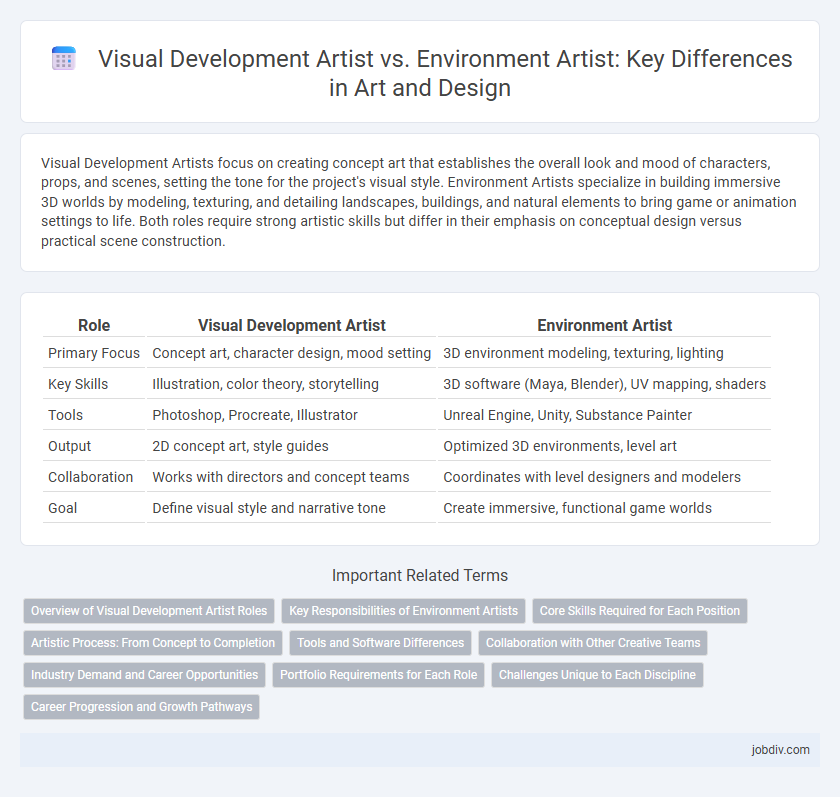Visual Development Artists focus on creating concept art that establishes the overall look and mood of characters, props, and scenes, setting the tone for the project's visual style. Environment Artists specialize in building immersive 3D worlds by modeling, texturing, and detailing landscapes, buildings, and natural elements to bring game or animation settings to life. Both roles require strong artistic skills but differ in their emphasis on conceptual design versus practical scene construction.
Table of Comparison
| Role | Visual Development Artist | Environment Artist |
|---|---|---|
| Primary Focus | Concept art, character design, mood setting | 3D environment modeling, texturing, lighting |
| Key Skills | Illustration, color theory, storytelling | 3D software (Maya, Blender), UV mapping, shaders |
| Tools | Photoshop, Procreate, Illustrator | Unreal Engine, Unity, Substance Painter |
| Output | 2D concept art, style guides | Optimized 3D environments, level art |
| Collaboration | Works with directors and concept teams | Coordinates with level designers and modelers |
| Goal | Define visual style and narrative tone | Create immersive, functional game worlds |
Overview of Visual Development Artist Roles
Visual Development Artists create concept art and detailed illustrations that establish the overall aesthetic, mood, and style for films, games, or animations. They focus on character design, color schemes, lighting, and composition to support storytelling and guide production teams. Their work serves as a blueprint for Environment Artists who build the immersive, three-dimensional worlds based on these initial designs.
Key Responsibilities of Environment Artists
Environment artists specialize in creating immersive, detailed backgrounds and settings that enhance the narrative and gameplay experience. Their key responsibilities include modeling, texturing, and lighting natural and architectural environments, ensuring visual consistency and optimization for various platforms. They collaborate closely with level designers and visual development artists to integrate assets seamlessly into the game world, balancing aesthetics and performance.
Core Skills Required for Each Position
Visual Development Artists excel in concept creation, strong storytelling abilities, and character design, focusing on mood, lighting, and color theory to establish a cohesive visual narrative. Environment Artists specialize in 3D modeling, texturing, and creating immersive landscapes with proficiency in software such as Maya, Blender, and Unreal Engine, emphasizing spatial awareness and architectural accuracy. Both roles demand a deep understanding of artistic fundamentals, but Visual Development leans towards pre-production creativity while Environment Art focuses on the technical realization of game or film settings.
Artistic Process: From Concept to Completion
A Visual Development Artist crafts initial concept art that defines mood, lighting, and color palettes, establishing the artistic direction early in production. An Environment Artist translates these concepts into detailed 3D environments, focusing on geometry, textures, and spatial composition to create immersive virtual worlds. Both roles require iterative collaboration, with Visual Development Artists refining ideas based on feedback and Environment Artists ensuring technical feasibility and visual consistency throughout asset completion.
Tools and Software Differences
Visual Development Artists primarily use software like Adobe Photoshop and Procreate to create concept sketches and detailed character designs, emphasizing color theory and mood setting. Environment Artists focus more on 3D modeling tools such as Autodesk Maya, Blender, and Substance Painter to build immersive, textured game or film environments. Both roles require proficiency in Unreal Engine or Unity for real-time visualization, but their toolsets reflect distinct artistic workflows and end goals.
Collaboration with Other Creative Teams
Visual Development Artists collaborate closely with character designers, storyboard artists, and art directors to establish the overall style and mood that guide the production. Environment Artists work primarily with lighting technicians, 3D modelers, and level designers to create immersive, detailed settings that support gameplay and narrative flow. Seamless communication between these roles ensures cohesive visual storytelling and a unified aesthetic throughout the project.
Industry Demand and Career Opportunities
Visual Development Artists specialize in concept art that shapes characters, props, and settings, serving as the foundation for animated films, video games, and visual storytelling projects, resulting in high demand within pre-production studios. Environment Artists focus on creating detailed, immersive 3D worlds and backgrounds that bring virtual spaces to life in games and films, with strong career opportunities in AAA game development and VR experiences. Both roles offer growth potential, but Environment Artists often find more direct employment opportunities due to the increasing need for complex, interactive environments in current entertainment media.
Portfolio Requirements for Each Role
A Visual Development Artist's portfolio must showcase strong concept art skills, character designs, color theory mastery, and the ability to visualize mood and lighting to guide a project's overall aesthetic. In contrast, an Environment Artist's portfolio emphasizes detailed 3D modeling, texture creation, level design, and proficiency in terrain and asset integration within game engines like Unreal or Unity. Both roles require a solid foundation in storytelling through visuals, but the Visual Development Artist leans towards ideation and style exploration, while the Environment Artist focuses on execution and immersive space creation.
Challenges Unique to Each Discipline
Visual Development Artists face challenges in concept ideation, requiring strong storytelling skills and the ability to create original characters and worlds that align with a project's narrative vision. Environment Artists confront technical constraints while building immersive, detailed 3D landscapes, often balancing aesthetic quality with performance optimization for real-time applications. Both disciplines demand deep collaboration across departments but differ significantly in their focus on early-stage conceptual creativity versus detailed environmental realization.
Career Progression and Growth Pathways
Visual Development Artists primarily focus on conceptualizing and designing characters, props, and scenes, shaping the aesthetic foundation for projects, while Environment Artists specialize in creating detailed, immersive 3D settings and landscapes. Career progression for Visual Development Artists often advances toward roles like Lead Visual Development Artist or Art Director, emphasizing creativity and vision, whereas Environment Artists typically progress to Senior Environment Artist or Environment Art Supervisor, highlighting technical expertise and project management. Both pathways offer opportunities in specialized branches such as virtual reality and gaming, with growth dependent on mastering cutting-edge software, storytelling skills, and collaboration within multidisciplinary teams.
Visual Development Artist vs Environment Artist Infographic

 jobdiv.com
jobdiv.com